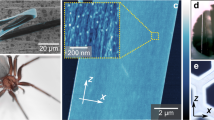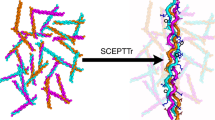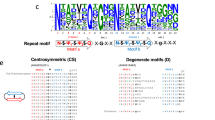Abstract
A MODEL of the two-phase structure of fibrous α-keratin has been evolved, starting with the α–β fold of Astbury et al.1 and thence via the concept of α-helices to the coiled-coil models of Pauling and Corey2 and of Crick3, and at present to the detailed schemes of packing recently proposed by Fraser, MacRae and Rogers4 and by Johnson and Sikorski5. The successive stages of this development have resulted primarily from attempts to give a more accurate explanation of the observed X-ray diffraction patterns. In addition, however, each advance has been judged by its success in explaining the ‘high’ densities found for keratin, and all have been found wanting because they led to lower crystalline densities than the values actually measured (definitive values given by Fraser and MacRae6 range from 1.283 g/c.c. for cow horn to 1.335 g/c.c. for echidna quill tip, at 25° C). This reasoning appears to rest on a false analogy with polymers, involving the assumption that the density of the crystalline phase is necessarily greater than that of the non-crystalline phase. Because this assumption is still influencing current thought on keratin ultra-structure it seems worth while to point out three deficiencies in the polymer analogy.
This is a preview of subscription content, access via your institution
Access options
Subscribe to this journal
Receive 51 print issues and online access
$199.00 per year
only $3.90 per issue
Buy this article
- Purchase on Springer Link
- Instant access to full article PDF
Prices may be subject to local taxes which are calculated during checkout
Similar content being viewed by others
References
Astbury, W. T., and Woods, H. J., Phil. Trans. Roy. Soc., A, 232, 333 (1933). Astbury, W. T., and Bell, F. O., Nature, 147, 696 (1941).
Pauling, L., and Corey, R. B., Nature, 171, 59 (1953).
Crick, F. H. C., Nature, 170, 882 (1952).
Fraser, R. B. D., MacRae, T. P., and Rogers, G. E., Nature, 193, 1052 (1962).
Johnson, D. J., and Sikorski, J., Nature, 194, 31 (1962).
Fraser, R. B. D., and MacRae, T. P., Text. Res. J., 27, 384 (1957).
Bradbury, J. H. (private communication).
Alexander, P., and Hudson, R. F., Wool: Its Chemistry and Physics (Chapman and Hall, London, 1954).
Gillespie, J. M., in Sulphur in Proteins, 51 (Academic Press, New York, 1959).
Treloar, L. R. G., Trans. Farad. Soc., 37, 84 (1941).
Bunn, C. W., Proc. Roy. Soc., A, 180, 40 (1942).
Mason, P., J. Chem. Phys., 35, 1523 (1961).
Martin, G. M., and Mandelkern, L., J. Res. U.S. Nat. Bur. Stand., 62, 141 (1959).
Moore, C. G., Mullins, L., and Swift, P. McL., J. App. Polymer Sci., 5, 293 (1961).
Haly, A. R., and Swanepoel, O. A., Text. Res. J., 31, 966 (1961).
Author information
Authors and Affiliations
Rights and permissions
About this article
Cite this article
MASON, P. Density and Structure of Alpha-Keratin. Nature 197, 179–180 (1963). https://doi.org/10.1038/197179a0
Issue Date:
DOI: https://doi.org/10.1038/197179a0
This article is cited by
-
Multibody analysis and soft tissue strength refute supersonic dinosaur tail
Scientific Reports (2022)
-
A numerical–thermal–thermographic NDT evaluation of an ancient marquetry integrated with X-ray and XRF surveys
Journal of Thermal Analysis and Calorimetry (2022)
-
Electron paramagnetic resonance in human fingernails: the sponge model implication
Radiation and Environmental Biophysics (2008)
Comments
By submitting a comment you agree to abide by our Terms and Community Guidelines. If you find something abusive or that does not comply with our terms or guidelines please flag it as inappropriate.



